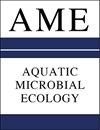隐虫猎物的游动行为影响埋伏食性纤毛虫的捕食偏好
IF 1.1
4区 环境科学与生态学
Q3 ECOLOGY
引用次数: 3
摘要
混合营养纤毛虫是一种依靠隐生猎物运动来遭遇和感知猎物的伏击食饵动物;因此,隐种特有的游泳行为会影响红毛鼠对猎物的偏好。本研究采用高速微尺度成像系统对3种隐生植物(Teleaulax amphioxeia、Storeatula major和Guillardia theta)的游泳行为进行了量化,并对M. rubrum-T进行了定量显微摄像。文昌鱼捕食者-猎物的相互作用。圆形鳞鱼是红毛鳞鱼的首选猎物,沿相当直的路径以155±73µm s-1的平均速度游动。相比之下,S. major以64±16µm s-1的速度有规律地向下或向上缓慢翻滚,而G. theta以57±15µm s-1的速度以环形/弯曲轨迹缓慢移动;两者都不支持红分枝杆菌的生长。只有在不动的被动下沉时,红藻才会在8.2±8.2µm的反应距离内发现并攻击游动的amphioxeia。看起来,红绒螯虾最初需要用口触须戳文昌鱼的腹侧后部,随后在短时间内多次戳猎物,以损害猎物的逃脱能力,可能是通过向猎物排出分泌物来实现的。amphioxeia也对附近的捕食者做出反应,像S. major在正常游泳时一样,转换成翻滚的姿势,这表明它是一种有效的反捕食者防御行为,可以防止M. rubrum准确地戳到猎物的腹侧后部。文昌鱼以明显更高的速度游动,为文昌鱼带来了足够高的猎物遭遇和流体动力学信号,从而部分解释了文昌鱼选择猎物的能力。本文章由计算机程序翻译,如有差异,请以英文原文为准。
Swimming behavior of cryptophyte prey affects prey preference of the ambush-feeding ciliate Mesodinium rubrum
The mixotrophic ciliate Mesodinium rubrum is an ambush feeder relying on cryptophyte prey motility for prey encounter and perception; therefore, cryptophyte species-specific swimming behaviors affect M. rubrum’s prey preference. Here, a high-speed microscale imaging system was used to quantify the swimming behaviors of 3 cryptophyte species (Teleaulax amphioxeia, Storeatula major, and Guillardia theta) and to conduct quantitative microvideography of M. rubrum-T. amphioxeia predator-prey interaction. T. amphioxeia, a preferred prey of M. rubrum, swam at path-averaged speeds of 155 ± 73 µm s-1 along rather straight paths. In contrast, S. major regularly tumbled slowly downward or upward at 64 ± 16 µm s-1, while G. theta moved slowly in looped/curved trajectories at 57 ± 15 µm s-1; neither supports M. rubrum growth. Only while motionlessly sinking passively did M. rubrum detect and initiate an attack on swimming T. amphioxeia at reaction distances of 8.2 ± 8.2 µm. It seemed that M. rubrum needed to use oral tentacles to initially poke T. amphioxeia’s ventral posterior part and subsequently poke the prey multiple times in a short duration to compromise the prey’s escape ability, presumably by discharging extrusomes into the prey. T. amphioxeia also responded to nearby predators by switching to tumbling similar to S. major in normal swimming, suggesting an effective anti-predator defense behavior that prevents M. rubrum from accurately poking the prey’s ventral posterior part. T. amphioxeia swimming at significantly higher speeds leads to sufficiently high prey encounters and hydrodynamic signals for M. rubrum, thereby partially explaining M. rubrum’s ability to select T. amphioxeia prey.
求助全文
通过发布文献求助,成功后即可免费获取论文全文。
去求助
来源期刊

Aquatic Microbial Ecology
环境科学-海洋与淡水生物学
CiteScore
3.30
自引率
0.00%
发文量
8
审稿时长
3.0 months
期刊介绍:
AME is international and interdisciplinary. It presents rigorously refereed and carefully selected Research Articles, Reviews and Notes, as well as Comments/Reply Comments (for details see AME 27:209), Opinion Pieces (previously called ''As I See It'') and AME Specials. For details consult the Guidelines for Authors. Papers may be concerned with:
Tolerances and responses of microorganisms to variations in abiotic and biotic components of their environment; microbial life under extreme environmental conditions (climate, temperature, pressure, osmolarity, redox, etc.).
Role of aquatic microorganisms in the production, transformation and decomposition of organic matter; flow patterns of energy and matter as these pass through microorganisms; population dynamics; trophic interrelationships; modelling, both theoretical and via computer simulation, of individual microorganisms and microbial populations; biodiversity.
Absorption and transformation of inorganic material; synthesis and transformation of organic material (autotrophic and heterotrophic); non-genetic and genetic adaptation; behaviour; molecular microbial ecology; symbioses.
 求助内容:
求助内容: 应助结果提醒方式:
应助结果提醒方式:


